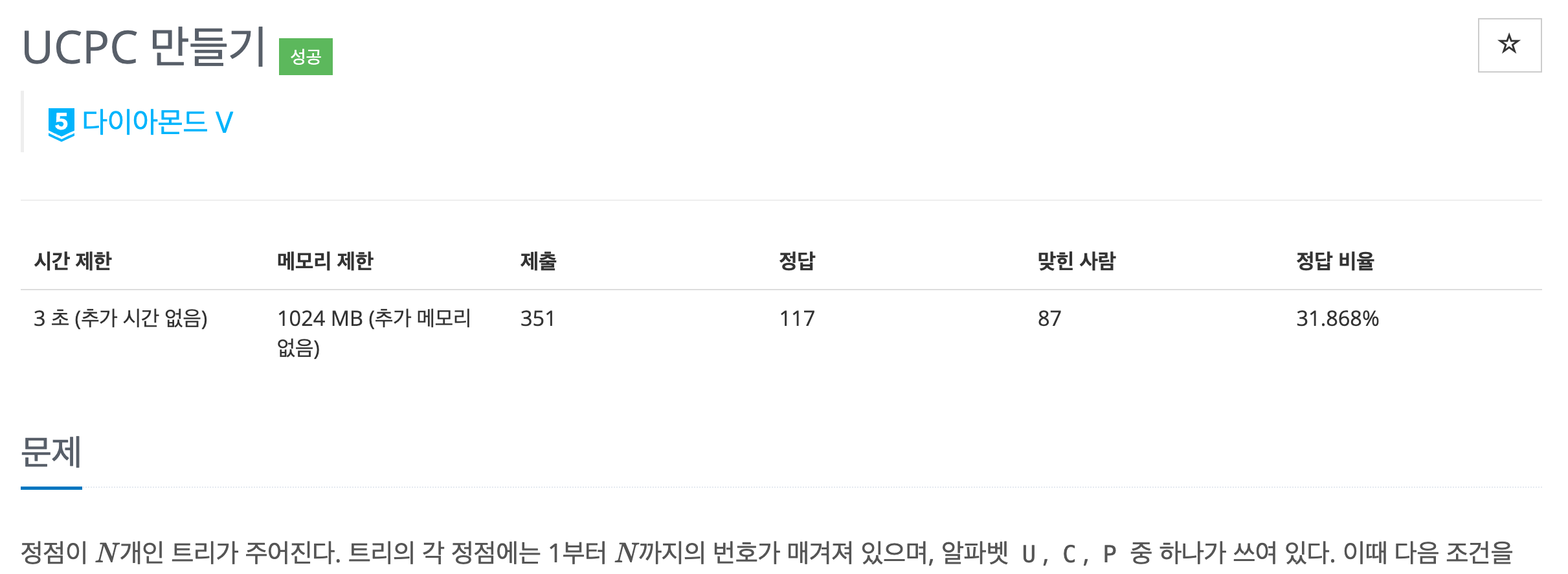BOJ 22360 - UCPC 만들기

라는 해시를 관리한다.
각각 1,2,1 개 이상이 있다면 그만큼 모두 빼줘도 무관하다.
예를 들어, 2,5,4 개가 있다면 0,1,2 개에 대한 해시로 생각해도 무관하다.
어떤 centroid에서 자식들에 대한 해시를 업데이트 해주며, 이제 어떤 경로에서 가 각각 있는것과 대응되는 해시값의 개수를 세주는 것이 정답이다.
int n;
vi ch;
int idx(char c) {
if (c == 'U') return 0;
if (c == 'C') return 1;
if (c == 'P') return 2;
assert(-1);
}
array<int, 3> normal(int u, int c, int p) {
int q = min({u, p, c / 2});
u -= q;
c -= q * 2;
p -= q;
return {u, c, p};
}
inline ll H(int u, int c, int p) {
auto nm = normal(u, c, p);
u = nm[0], c = nm[1], p = nm[2];
return 1ll * p + 1ll * 200001 * u + 1ll * 200001 * 200001 * c;
}
ll ans = 0;
struct centroid {
int N;
vi tree_size, vis;
vvi _edges;
centroid(int N) : N(N), tree_size(N), vis(N), _edges(N) {}
void add_edge(int u, int v) { _edges[u].pb(v); }
int get_size(int cur, int p) {
tree_size[cur] = 1;
for (int to: _edges[cur])if (to != p && !vis[to])tree_size[cur] += get_size(to, cur);
return tree_size[cur];
}
int get_centroid(int cur, int p, int cap) {
for (int to: _edges[cur]) if (to != p && !vis[to] && tree_size[to] * 2 > cap) return get_centroid(to, cur, cap);
return cur;
}
// 반대쪽에 UUUUUUUCPC 가 있다고 하자
// P 7개와 C 14개가 있어야 한다
map<ll, ll> hashes, added;
int cur_cent = -1;
// centroid를 제외한 u,c,p, 의 개수만 관리
void dfs(int cur, int u, int c, int p, int par) {
auto nm = normal(u, c, p);
u = nm[0], c = nm[1], p = nm[2];
ll h = H(u + (ch[cur_cent] == 0), c + (ch[cur_cent] == 1), p + (ch[cur_cent] == 2));
added[h]++;
//debug("add", h, cur, u + (ch[cur_cent] == 0), c + (ch[cur_cent] == 1), p + (ch[cur_cent] == 2));
int mx_q = max({u, p, (c + 1) / 2});
int need_u = mx_q - u;
int need_c = mx_q * 2 - c;
int need_p = mx_q - p;
ll target_h = H(need_u, need_c, need_p);
//debug("query", need_u, need_c, need_p, target_h);
if (hass(hashes, target_h)) {
debug(cur, cur_cent, u, c, p, need_u, need_c, need_p);
ans += hashes[target_h];
}
for (int to: _edges[cur]) {
if (to != par && !vis[to]) {
dfs(to, u + (ch[to] == 0), c + (ch[to] == 1), p + (ch[to] == 2), cur);
}
}
}
int build_tree(int cur, int p = -1) {
cur = get_centroid(cur, -1, get_size(cur, -1));
vis[cur] = 1;
cur_cent = cur;
hashes[H(ch[cur] == 0, ch[cur] == 1, ch[cur] == 2)]++;
for (int to: _edges[cur]) {
if (!vis[to]) {
dfs(to, ch[to] == 0, ch[to] == 1, ch[to] == 2, cur);
for (const auto &[h, cnt]: added) hashes[h] += cnt;
added = {};
}
}
hashes = {};
for (int to: _edges[cur])if (!vis[to]) to = build_tree(to, cur);
return cur;
}
};
void solve() {
cin >> n;
string s;
cin >> s;
for (int i = 0; i < n; i++) ch.pb(idx(s[i]));
centroid cent(n);
for (int i = 0, u, v; i < n - 1; i++) {
cin >> u >> v, u--, v--;
cent.add_edge(u, v);
cent.add_edge(v, u);
}
cent.build_tree(0);
cout << ans;
}


Comments